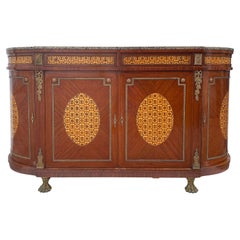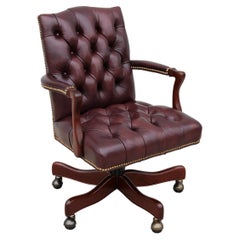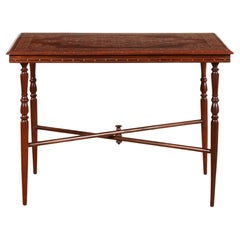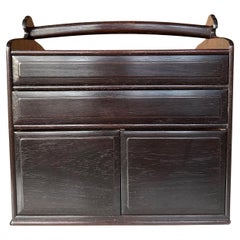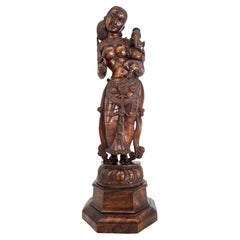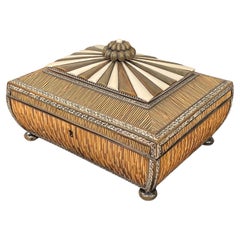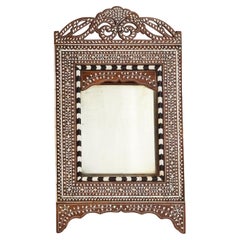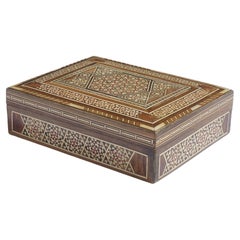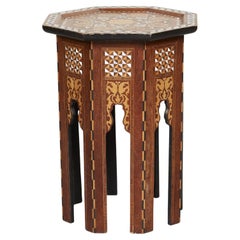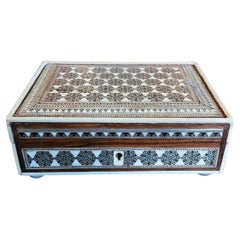Sandalwood Furniture
to
9
42
5
48
1
1
4
3
2
1
1
1
3
22
23
2
10
4
3
1
1
1
1
50
352,709
291,940
221,202
147,089
35
29
23
7
4
50
49
50
3
2
2
1
1
Material: Sandalwood
Regency Anglo Indian Quill Work Vizagapatam Sandalwood Sewing Box
Located in Huntington, NY
This fine Regency period quill work, bone, ivory & sandalwood sewing box
with intact interior w sewing implements.
Category
Early 19th Century Indian Regency Antique Sandalwood Furniture
Materials
Bone, Sandalwood, Ivory
Indian Inlaid Mirror with Tambour Door
Located in Greenwich, CT
Fine inlaid sandalwood mirror with elaborate bone and ebony detailing to fretwork top, deep mitered sides and scalloped, arched base. Original mirror inside a black and white chevron...
Category
1890s Indian Anglo-Indian Antique Sandalwood Furniture
Materials
Sandalwood
Exceptional Anglo-Indian Stag Horn Veneered Sewing / Work Box From Vizagapatam
Located in Chapel Hill, NC
An unusually large stag horn veneered sandal wood sewing box from Vizagapatam, India. This large, fitted box in the Regency taste has tapered sides and a two-tiered sloped lid, all c...
Category
Mid-19th Century Indian Anglo-Indian Antique Sandalwood Furniture
Materials
Antler, Sandalwood
Intricately inlaid vintage Damascus box with hinged lid
Located in Kenilworth, IL
Intricately inlaid vintage Damascus box with hinged lid in hardwood, sandalwood, ebony, and camel bone. The box features a geometric inlaid field over fiv...
Category
Early 20th Century Sandalwood Furniture
Materials
Bone, Hardwood, Ebony, Sandalwood
Moorish Drinks Table
Located in Greenwich, CT
A drinks table in the Moorish style with an octagonal top and faceted octagonal base with arched colonnaded legs having intricate marquetry, inlay and moth...
Category
Late 19th Century English Antique Sandalwood Furniture
Materials
Sandalwood
19C Anglo Indian Bombay MOP Sadeli Mosaic Trinket Box
Located in Dallas, TX
PRESENTING a LOVELY 19C Anglo Indian Bombay MOP (Mother of Pearl) Sadeli Mosaic Trinket Box from circa 1875-85.
Gorgeously detailed and hand-crafted ‘sadeli mosaic’ inlay, from the Bombay Area, with deep greens with silver, pewter, mother of pearl, bone and ebony in geometric patterns.
The box case, is made of sandalwood but completely covered in MOP, bone, faux ivory, ebony and mosaic inlay.
Edged with faux ivory and banded with a different pattern of sadeli mosaic.
Some minor damage to the top (repair is obvious in pics) and ivorine replacements to some edging, but it still a BEAUTIFUL BOX and of real QUALITY!
The mosaic work is FABULOUS!
Box opens to reveal its original blue velvet lining.
It sits on 4 (recently added) silvered button feet.
SADELI MOSAIC: “Anglo Indian boxes were made in India for the English residents from the early part of the 18th century. They were brought back or sent back to England usually by the people who had commissioned them. From the beginning of the nineteenth century they were imported more commercially, although not in any significant numbers until the middle decades. They were very highly valued, especially the early ones, to the extent that the designs were copied on late 19th and early 20th century tins.
The ancient art of Sadeli Mosaic is said to have been introduced from Shiraz in Persia via Sind to Bombay, a long time before the Anglo Indian boxes were made. It was a technique, which required a high degree of skill and patience. It was executed very lavishly, in that the frequent cuts wasted a great amount of the precious materials used. The workmanship was however more than commensurable to the value of the materials.
Ivory, silver, pewter (or other metals), wood and horn were cut into faceted rods which were bound together to form geometric patterns. When the glue has set, the rods were sliced in transverse sections. This gave the maker a number of angled circular pieces in the original pattern. Several variations of patterns could be achieved by combining the materials in different ways. The ivory was sometimes dyed green to give an extra color.
The mosaic pieces in a combination of patterns, often separated by ivory, ebony, horn or silver stringing were used to veneer sandalwood boxes. In the early boxes, which date from the turn of the 18th to the 19th century, there are large panels of mosaic covering tops and sides of boxes. It took incredible skill to cover such large areas without any shakes or wavering of the pattern. The corners and joins on these boxes are impeccably matched.
The makers (reputed to be Persian) of Sadeli mosaic made in the first two decades of the 19th century displayed a total understanding of the qualities of the different materials they used. They combined substances, which can expand and contract according to atmospheric conditions with others, which are hard and unyielding. The result was a sharp definition of the lines and patterns, which made up the whole design.
On the early boxes the designs look deceptively simple. The fact is, they emerged from a culture, which had mastered geometry and understood how to generate a pattern from a set number of points. The patterns are so harmoniously combined that their incredible complexity is not immediately apparent.
The earliest Sadeli boxes...
Category
Late 19th Century Indian Anglo-Indian Antique Sandalwood Furniture
Materials
Silver
18 C, Indo-Portuguese Vargueno Mini Cabinet
Located in Dallas, TX
Presenting a fabulously rare 18c Indo-Portuguese Vargueno mini cabinet.
Extremely rare, highly important and desirable colonial piece !
It is an In...
Category
Late 18th Century Indian Anglo-Indian Antique Sandalwood Furniture
Materials
Brass
Middle Eastern Moorish Jewelry Box
Located in Delray Beach, FL
exquisite middle Eastern Moorish Syrian inlay jewelry box. This box is intricately inlaid with Moorish motif designs which have been uniquely inlaid with bone, mother of pearl and f...
Category
20th Century Asian Islamic Sandalwood Furniture
Materials
Mother-of-Pearl, Sandalwood
19C Anglo Ceylonese Specimen Wood Trinket Box
Located in Dallas, TX
PRESENTING A BEAUTIFUL and RARE 19C Anglo Ceylonese Specimen Wood Trinket Box.
Made in ‘Galle’, Ceylon (now Sri Lanka) circa 1860-80.
Made for the ex...
Category
19th Century Sri Lankan Anglo-Indian Antique Sandalwood Furniture
Materials
Bone, Hardwood, Ebony, Sandalwood
Ceylonese 'Sri Lankan' Ebony Writing Slope
Located in Greenwich, CT
Very fine early 19th century carved ebony writing slope, the exterior richly carved with foliate decoration, the interior profusely inlaid with bon...
Category
Early 19th Century Sri Lankan Anglo-Indian Antique Sandalwood Furniture
Materials
Bone, Ebony, Sandalwood
Edward Wormley Sandalwood and Blackened Steel Coffee Table for Dunbar, 1950s
Located in Miami, FL
Rare Edward Wormley designed coffee table with nine inset blackened steel plates on a sandalwood Parsons style frame. Manufactured by Dunbar, 1950s. The sandalwood has been stripped ...
Category
Mid-20th Century American Mid-Century Modern Sandalwood Furniture
Materials
Steel
19C Anglo Indian Highly Carved Teak Sadeli Mosaic Inlaid Sewing Box
Located in Dallas, TX
PRESENTING A LOVELY 19C Anglo Indian Highly Carved Sadeli Mosaic Inlaid Sewing Box.
Made in Bombay, India, circa 1880.
The box is made of sandalwood with highly carved raised teak wood panels on all sides, depicting temple scenes, animals and foliage.
The box is in a sarcophagus form.
It is edged in bone (and we can tell it is bone and not ivory, from the color and evidence of capillaries, which are not found in ivory), and banded with Bombay Sadeli mosaic and ebony veneer.
The lid opens to reveal a removable tray with various open compartments and lidded compartments. 5 lidded compartments, 1 unlidded compartment and 8 holders for thimbles, etc
The tray lifts to reveal a blue velvet (original) lined section, for storing jewelry etc, with sections for collars etc.
The inside of the lid has a removable mirror (the mirror is missing on this one but can easily be replaced). Behind the mirror is the original green velvet lining.
It has its original brass carry handles on the sides and sits on 4 silvered button feet (of recent origin).
Some repairs to the exterior and condition issues (priced accordingly), but still a LOVELY COLLECTIBLE box!
These boxes were made by superb Indian craftsmen, specifically for sale to the ruling British elite. These types of boxes, carved padouk and sandalwood, (whilst beautiful and superbly crafted) were of a lesser quality, than the more profusely and intricately mosaic inlay, tortoiseshell and ivory boxes, made for the British ‘Upper Classes’ in the areas of Bombay and Vizagapatam. These type of boxes were much more affordable back in 1880 (and indeed today) and would probably have been bought by mid-level diplomats, civil servants or visitors.
Sewing boxes (in general), were in EVERY Victorian home in Britain in the 19th century and like other boxes etc were ‘status symbols’ of your place in society! The more ornate the box, the more ‘Upper Class’ you were!
SADELI MOSAIC: “Anglo Indian boxes were made in India for the English residents from the early part of the 18th century. They were brought back or sent back to England usually by the people who had commissioned them. From the beginning of the nineteenth century they were imported more commercially, although not in any significant numbers until the middle decades. They were very highly valued, especially the early ones, to the extent that the designs were copied on late 19th and early 20th century tins.
The ancient art of Sadeli Mosaic is said to have been introduced from Shiraz in Persia via Sind to Bombay, a long time before the Anglo Indian boxes were made. It was a technique, which required a high degree of skill and patience. It was executed very lavishly, in that the frequent cuts wasted a great amount of the precious materials used. The workmanship was however more than commensurable to the value of the materials.
Ivory, silver, pewter (or other metals), wood and Horn were cut into faceted rods which were bound together to form geometric patterns. When the glue has set, the rods were sliced in transverse sections. This gave the maker a number of angled circular pieces in the original pattern. Several variations of patterns could be achieved by combining the materials in different ways. The ivory was sometimes dyed green to give an extra color.
The mosaic pieces in a combination of patterns, often separated by ivory, ebony, Horn or silver stringing were used to veneer sandalwood boxes. In the early boxes, which date from the turn of the 18th to the 19th century, there are large panels of mosaic covering tops and sides of boxes. It took incredible skill to cover such large areas without any shakes or wavering of the pattern. The corners and joins on these boxes are impeccably matched.
The makers (reputed to be Persian) of Sadeli mosaic made in the first two decades of the 19th century displayed a total understanding of the qualities of the different materials they used. They combined substances, which can expand and contract according to atmospheric conditions with others, which are hard and unyielding. The result was a sharp definition of the lines and patterns, which made up the whole design.
On the early boxes the designs look deceptively simple. The fact is, they emerged from a culture, which had mastered geometry and understood how to generate a pattern from a set number of points. The patterns are so harmoniously combined that their incredible complexity is not immediately apparent.
The earliest Sadeli boxes...
Category
Late 19th Century Indian Anglo-Indian Antique Sandalwood Furniture
Materials
Bone, Sandalwood, Teak
18C Indo-Persian Campaign Vanity Box
Located in Dallas, TX
PRESENTING AN EXTREMELY RARE AND HIGHLY IMPORTANT Indo-Persian Campaign Vanity Box from circa 1780-1800.
Box inlaid with exquisite mosaic inlay.
In the Indo-Persian style of mosaic with Islamic styles.
The mosaic consists of green semi precious stone, bone, brass and pewter in star shaped geometric designs.
Box opens up to reveal a travel mirror...
Category
18th Century Indian Anglo-Indian Antique Sandalwood Furniture
Materials
Multi-gemstone, Brass
Classic Cabot Wrenn Graham Tufted Burgundy Leather Executive Swivel Desk Chair
By Cabot Wrenn
Located in Secaucus, NJ
Fabulous traditional Graham deep button tufted leather swivel and tilt executive desk chair by Cabot Wrenn.
A classic timeless and luxurious style inspired by the 18th and 19th century design.
Beautifully handcrafted by skilled artisans using high-quality materials.
The leather is rich in color and variety of grain texture making each chair different.
This piece will bring a sense of history and elegance to any interior at home or office.
Please note I have five chairs available, selling them individually "The price listed is for one chair"
Specifications:
Upholstery: Genuine top grain high quality Antelope wine Burgandy leather
Mahogany hand-carved arms
Brass Hancock nail trim
Mahogany oiled sandalwood hand-carved 5-star base feature prong steel interiors with antique brass casters...
Category
21st Century and Contemporary American Chesterfield Sandalwood Furniture
Materials
Brass, Steel
Edward Wormley for Dunbar Cabinet with Brass Hardware, 1950s
Located in Dallas, TX
Beautiful sideboard cabinet designed by Edward Wormley for Dunbar, made of sandalwood with solid brass hardware. Cabinet has drawers on each side, center Lucite pull out shelf and on...
Category
Mid-20th Century North American Mid-Century Modern Sandalwood Furniture
Materials
Brass
Hand Carved Indian Room Divider
Located in Brooklyn, NY
Six foot tall wood screen with four 19.75" panels, fully carved and pierced. Measuring over six feet wide when opened, this is a beautiful option for closing off a room.
Please confi...
Category
20th Century Anglo-Indian Sandalwood Furniture
Materials
Sandalwood
Anglo Raj Hand-Carved Decorative Jewelry Box
By Rajhastani
Located in North Hollywood, CA
Hand-carved Anglo Raj early 20th century carved wood box richly decorated overall with arabesques and floral carving.
Hinged lid shallow relief carving with interior lined with red r...
Category
Early 20th Century Indian Anglo Raj Sandalwood Furniture
Materials
Sandalwood
Rare Model 14.958 Floor Lamp by Rispal
By Rispal
Located in Los Angeles, CA
Rare Model 14.958 Floor Lamp by Rispal. Designed and manufactured in France, circa 1950s. Rare sculptural floor lamp with slender custom wood stem, interloc...
Category
1950s French Mid-Century Modern Vintage Sandalwood Furniture
Materials
Stainless Steel, Steel, Metal
19C Anglo Indian Highly Carved Sadeli Mosaic Sarcophagus Sewing Box
Located in Dallas, TX
PRESENTING A GORGEOUS 19C Anglo Indian Highly Carved Sadeli Mosaic Sarcophagus Sewing Box.
Made in Bombay, India circa 1860-80.
Box made of sandalwood with highly carved teak wood reliefs and panels on all sides.
Edged with bone and ebony veneers and glorious sadeli mosaic, made from tiny pieces of faux ivory, pewter, green semi-precious stone.
The box is in a sarcophagus form with domed lid.
The original brass carry handles are on the sides.
The interior is in great condition and consists of a removeable mirror under the lid portion, with the original red velvet lining behind it.
The base is removeable and contains a number of lidded compartments.
6 of the interior lids on the base, are each inlaid with sadeli mosaic banding. The rest are also carved and chased.
The interior is fully complete with 7 lidded faux ivory/bone, thread canisters with sadeli domes and the original bone thimble.
The box sits on 4 brass ball or bun feet with the original velvet lining on the base.
Some minor repairs and losses, but this box is fully complete. This is ‘rare’ as many of these boxes have not survived in such condition!
Included in the sale are 2 photos that were in the box (under the base tray). Interestingly, one of them is a view of downtown Nassau, New Providence (Bermuda) from the early 20C and stamped on the rear. What a ‘journey’ this piece has made! Made in India … travelled to Bermuda, probably via Britain … back to Ireland (where we bought it) …. then to Texas!
These boxes were made by superb Indian craftsmen, specifically for sale to the ruling British elite. These types of boxes, carved padouk and sandalwood, (whilst beautiful and superbly crafted) were of a lesser quality, than the more profusely and intricately mosaic inlay, tortoiseshell and ivory boxes, made for the British ‘Upper Classes’ in the areas of Bombay and Vizagapatam. These type of boxes were much more affordable back in 1880 (and indeed today) and would probably have been bought by mid-level diplomats, civil servants or visitors.
Sewing boxes (in general), were in EVERY Victorian home in Britain in the 19th Century and like other boxes etc were ‘status symbols’ of your place in society! The more ornate the box, the more ‘Upper Class’ you were!
Of it’s type, this one, is one of the very higher quality one’s, than the norm!
SADELI MOSAIC: “Anglo Indian boxes were made in India for the English residents from the early part of the 18th century. They were brought back or sent back to England usually by the people who had commissioned them. From the beginning of the nineteenth century they were imported more commercially, although not in any significant numbers until the middle decades. They were very highly valued, especially the early ones, to the extent that the designs were copied on late 19th and early 20th century tins.
The ancient art of Sadeli Mosaic is said to have been introduced from Shiraz in Persia via Sind to Bombay, a long time before the Anglo Indian boxes were made. It was a technique, which required a high degree of skill and patience. It was executed very lavishly, in that the frequent cuts wasted a great amount of the precious materials used. The workmanship was however more than commensurable to the value of the materials.
Ivory, silver, pewter (or other metals), wood and horn were cut into faceted rods which were bound together to form geometric patterns. When the glue has set, the rods were sliced in transverse sections. This gave the maker a number of angled circular pieces in the original pattern. Several variations of patterns could be achieved by combining the materials in different ways. The ivory was sometimes dyed green to give an extra color.
The mosaic pieces in a combination of patterns, often separated by ivory, ebony, horn or silver stringing were used to veneer sandalwood boxes. In the early boxes, which date from the turn of the 18th to the 19th century, there are large panels of mosaic covering tops and sides of boxes. It took incredible skill to cover such large areas without any shakes or wavering of the pattern. The corners and joins on these boxes are impeccably matched.
The makers (reputed to be Persian) of Sadeli mosaic made in the first two decades of the 19th century displayed a total understanding of the qualities of the different materials they used. They combined substances, which can expand and contract according to atmospheric conditions with others, which are hard and unyielding. The result was a sharp definition of the lines and patterns, which made up the whole design.
On the early boxes the designs look deceptively simple. The fact is, they emerged from a culture, which had mastered geometry and understood how to generate a pattern from a set number of points. The patterns are so harmoniously combined that their incredible complexity is not immediately apparent.
The earliest Sadeli boxes...
Category
19th Century Indian Anglo-Indian Antique Sandalwood Furniture
Materials
Bone, Sandalwood, Teak
Pair Chinese India Red Sandalwood Solid Zitan Carved Low Back Arm Chair
Located in Danville, CA
We are proud to offer this pair of amazing Chinese solid zitan carved low back chairs. They have detail carving around their body. The back support and...
Category
Late 20th Century Chinese Qing Sandalwood Furniture
Materials
Sandalwood
Anglo-Indian Horn Veneered Sewing Box from Vizagapatam w/Fitted Interior/Drawer
Located in Chapel Hill, NC
Large Anglo-Indian sewing box with hinged lid opening to a fitted interior and interior compartment in the lid, a lower drawer on the front provides additional storage. The box made ...
Category
Mid-19th Century Indian Anglo-Indian Antique Sandalwood Furniture
Materials
Horn, Sandalwood
19C Anglo Ceylonese Lap Desk of Museum Quality
Located in Dallas, TX
Presenting an absolutely fantastic 19C Anglo Ceylonese lap desk of museum quality.
We can safely say that this is one of the finest lap desks we hav...
Category
Early 19th Century Sri Lankan Anglo-Indian Antique Sandalwood Furniture
Materials
Bone, Ebony, Sandalwood
Persian Desk Set with Khatam Mosaic
Located in Dallas, TX
PRESENTING A LOVELY Hand-painted Persian Desk Set with Khatam Mosaic.
Pair of items in the Set:
(1) Hand-painted Bone Plaque in Khatam Mosaic Frame, and...
Category
20th Century Persian Islamic Sandalwood Furniture
Materials
Brass
19th Century Anglo-Indian Mughal Box
Located in North Hollywood, CA
19th century Anglo-Indian Mughal wood box, inlaid and hand carved with the Taj Mahal and some flowers all around.
Jewelry box, Anglo-Raj box from India in great condition.
Nice Mughal Bombay Box...
Category
Late 19th Century Indian Anglo Raj Antique Sandalwood Furniture
Materials
Sandalwood
Anglo-Indian Footed Box with Lidded Compartments, 19th Century
Located in North Hollywood, CA
19th century Anglo-Indian wooden box fitted with various compartments finely hand carved.
The top is finely hand carved with the Taj Mahal.
The interior with removable hand carved nine-lidded compartments, the front cover has a mirror, the whole exhibiting very fine workmanship.
This fine late Victorian Anglo-Indian box from India is in great condition for it age.
A beautiful example of an Anglo-Indian fine art...
Category
Late 19th Century Indian Anglo-Indian Antique Sandalwood Furniture
Materials
Sandalwood
Exquisite 19th c. Luxury Compartmented Ceylonese Sailor's Box
Located in Greenwich, CT
An exquisite 19th century luxury sailor's box in sandalwood with dramatically contrasting bone and ebony geometric decoration and string inlay having raised center tier with sliding ...
Category
Late 19th Century Sri Lankan Anglo-Indian Antique Sandalwood Furniture
Materials
Sandalwood
19th Century Anglo-Indian Sadeli Mosaic Jewelry Box with Lidded Compartments
Located in North Hollywood, CA
19th century Anglo-Indian sandal wood box, Sadeli mosaic box fitted with various compartments finely hand-carved with the Taj Mahal.
Of sarcophagus form ...
Category
Late 19th Century Indian Anglo-Indian Antique Sandalwood Furniture
Materials
Sandalwood
Pair of Chinese Nobility Chairs
Located in Woodbury, CT
This pair of Chinese chairs was most likely produced for a nobleman in the late 1800s or very early 1900s. The stag featured prominently in the back of each splat is meant to represe...
Category
Early 20th Century Chinese Sandalwood Furniture
Materials
Sandalwood
Nepalese Sandalwood Buddha Tree, 20th Century
Located in Islamabad, PK
The sculpture, expertly carved from fragrant Nepalese sandalwood, stands as a testament to the rich tradition of wood carving in Nepal. The medium itself adds a sensory dimension to ...
Category
20th Century Nepalese Folk Art Sandalwood Furniture
Materials
Sandalwood
Vizagapatam Anglo-Indian Rectangular Box with Bone Inlaid
Located in North Hollywood, CA
Fabulous Anglo-Indian decorative box inlaid.
Made in Vizagapatam, situated on the south east coast of India, near Madras.
Great decorative inlaid pen box or jewelry box.
Inside dimen...
Category
20th Century Indian Anglo-Indian Sandalwood Furniture
Materials
Sandalwood
Marquetry Sideboard French, Granite, Inlay, Bronze Mounts and Feet
Located in Miami, FL
Marquetry Sideboard French, Granite, Inlay, Bronze Mounts and Feet
Offered for sale is a large 20th-century French design sideboard/credenza with marquetry inlays, gilt metal hardwa...
Category
Late 20th Century Sandalwood Furniture
Materials
Granite, Metal
19C Anglo Indian Carved Teak Wood and Sadeli Mosaic Box
Located in Dallas, TX
PRESENTING A LOVELY 19th century Anglo-Indian Carved Teak Wood and Sadeli Mosaic Box, featuring a carving of a Hunt Scene.
Made circa 1870 in Bombay, India during the Rule of the Br...
Category
Late 19th Century Indian Anglo-Indian Antique Sandalwood Furniture
Materials
Silver, Pewter
Fine Japanese Portable Tea Cabinet Meiji Period with Provenance
Located in Atlanta, GA
An antique Japanese portable cabinet finely fashioned out of Sandalwood, a fragrant and also one of the most expensive woods that was used to make small luxury pieces. The handled ca...
Category
Early 20th Century Japanese Meiji Sandalwood Furniture
Materials
Wood, Sandalwood
Antique Anglo-Indian Vizagapatam Stag Antler Horn Slope Top Writing Desk c 1800s
Located in Chicago, IL
Stag antler table top desk secretary or rather as described by a British expert: an Anglo-Indian stag antler writing slope table top desk, late 19th century from Vizagapatam, which was the headquarters of the Vizagapatam District of Madras during the British period. Stag Antler anything is rare and unusual today, especially when it is completely covered in carved strips of Natural unpolished Antler. Finding Stag Antler Writing Desks are beyond rare and in our 30-years in the Antique business...
Category
1870s Indian Black Forest Antique Sandalwood Furniture
Materials
Bone, Antler, Leather, Sandalwood
Inlaid Drinks Table
Located in Greenwich, CT
An Anglo-Indian drinks table having a rectangular sandalwood top with canted edge on a thin apron all elaborately inlaid with bone filigree, and standing on fine ring-turned legs joi...
Category
Late 19th Century Indian Antique Sandalwood Furniture
Materials
Sandalwood
Large 19th Century Sandalwood Jewellery Box, South India
Located in London, GB
The dense carving of this 19th century South Indian sandalwood jewellery box is so lively and animated.
Category
Late 19th Century Indian Antique Sandalwood Furniture
Materials
Sandalwood
Art Deco Secretaire Cabinet by Jules Deroubaix
Located in North York, ON
This Jules Deroubaix display cabinet secretaire is timeless, functional, and effortlessly chic. Made of burl sandalwood, it showcases a drop door paneled wit...
Category
1930s French Art Deco Vintage Sandalwood Furniture
Materials
Chrome, Brass
Modernist 1981 Sculptural Secret Table Box Carved In Marble Sandalwood And Shell
Located in Miami, FL
Sculptural marble secret box.
Exceptional decorative box, created by an American artist back in the 1981. This modernist box has been made up with carvings of white marble and sanda...
Category
1980s American Mid-Century Modern Vintage Sandalwood Furniture
Materials
Marble
19c Anglo Indian Highly Carved Teak and Sandalwood Sarcophagus Sewing Box
Located in Dallas, TX
PRESENTING A VERY NICE 19C Anglo Indian Highly Carved Teak and Sandalwood Sarcophagus Sewing Box.
Made in Bombay, India circa 1890-1900.
The box case/body is made of sandalwood wit...
Category
Late 19th Century Indian Anglo-Indian Antique Sandalwood Furniture
Materials
Bone, Sandalwood, Teak
Colonial 18th Century Vizagapatam Pen-Engraved Writing Desk with Silver Mounts
Located in Amsterdam, NL
A Vizagapatam pen-engraved veneered sandalwood portable writing desk with silver mounts
India, Coromandel coast, Visakhapatnam, circa 1875
...
Category
18th Century Indian British Colonial Antique Sandalwood Furniture
Materials
Sandalwood, Bone
Art Deco Python Sandalwood Cigar / jewelry box
Located in Westport, CT
Art Deco python and Channeled sandalwood Mens Cigar / storage box with chrome bar front , felt bottom
Category
Early 20th Century French Art Deco Sandalwood Furniture
Materials
Chrome
Anglo Raj Hand-Carved Wooden Decorative Jewelry Box
By Rajhastani
Located in North Hollywood, CA
Hand-carved large wooden Anglo-Raj jewelry box.
Early 20th century wood box richly decorated overall with arabesques and floral carving.
Hinged lid shallow relief carving with interi...
Category
Early 20th Century Indian Anglo Raj Sandalwood Furniture
Materials
Sandalwood
Early 20th Century Kitchen God Deity Statue
Located in Singapore, SG
A handsome wooden figure of the Kitchen God (灶神 in Chinese, pronounced zào shén), the Chinese name can also be translated into Stove God. He is a popular a...
Category
Early 20th Century Chinese Qing Sandalwood Furniture
Materials
Sandalwood
19C Anglo Indian Vizagapatam Bone and Shell Domed Stationery Box
Located in Dallas, TX
PRESENTING A LOVELY 19C Anglo Indian Vizagapatam Bone and Shell Domed Stationery Box – ‘Alice’s Box’.
Made in Vizagapatam, India, circa 1860-80.
We call this one: “Alice’s Box”! It has lived ‘a hard, well used and traveled life’, as is evident from the number of losses and repairs, as is obvious from the photos, especially to the faux ivory panels and bands to the top. The bonus to the loss of the frieze panels to the dome has a ‘bonus’, however, as their loss has revealed the most GORGEOUS faux blonde tortoiseshell underneath!
The box is dome/casket shaped.
The top has 3 bands, with the center one being the original. The 2 side bands are later ivorine.
The faux ivory and hand-painted medallions on the domed lid, have been saved and they depict Hindu Gods, Vishnu and Shiva.
The front and side panels are still in pretty good shape and are decorated with lac ink (indelible ink made from crushed beetles) depicting lovely floral designs.
The domed lid open to reveal a series of open compartments for envelopes, writing paper etc. and one lidded panel for stamps.
Inside the box are 2 paper labels: one probably being the original item ticket and the other with:
” Alice’s address is 272 Ashworth Ave, Toronto 4, Ontario”.
Probably, the original owner? Hence, we call it ‘Alice’s Box’.
What a journey/life this box has had!
Made in India, made its way to Canada, back to Ireland and then to Texas!
This is why, WE LOVE ANTIQUES...
Category
19th Century Indian Anglo-Indian Antique Sandalwood Furniture
Materials
Bone, Shell, Sandalwood
An Indian Raj period carved figure of the Goddess Parvati, circa 1900
Located in Central England, GB
This superb hand carved sandalwood figure is Indian from the Raj period and dates to circa 1900.
It depicts the Hindu goddess Parvati, who represents love, fertility and devotion.
Parvati is beautiful. She is semi-naked and very ornate in her elaborate costume. She is holding her Deity son Ganesha, who is part human with an elephant’s head and is known in Hindu mythology as the remover of obstacles.
This remarkable figure group is carved from solid sandalwood, the very material that Hindu mythology suggests Parvati made her son Ganesha from.
The figure group is exceptionally well carved equal to what could be described in European circles as exhibition quality.
The finely carved figure is raised and mounted onto an elaborate carved and moulded stepped stand made from matching figured sandalwood.
This very fine piece of Hindu art...
Category
Early 20th Century Anglo Raj Sandalwood Furniture
Materials
Sandalwood
COLLECTABLE ART DECO 1920'S SALMON PINK GLASS MANTLE CLOCK MADE IN ENGLANd
Located in West Sussex, Pulborough
We are delighted to offer for sale this absolutely exquisite, totally original, Art Deco Salmon Pink glass mantle clock period foxing
A very good ...
Category
1920s British Art Deco Vintage Sandalwood Furniture
Materials
Chrome
Anglo Raj Hand Carved Wooden Decorative Jewelry Box
By Rajhastani
Located in North Hollywood, CA
Hand carved large wooden Anglo-Raj jewelry box.
Early 20th century wood box richly decorated overall with arabesques and floral carving.
Hinged lid shallow relief carving with inte...
Category
Early 20th Century Indian Anglo Raj Sandalwood Furniture
Materials
Sandalwood
English Georgian Satinwood Veneered Tea Caddy Box
Located in Queens, NY
English Georgian rectangular satinwood veneered and banded edge tea caddy box hinged top and silver handle revealing two compartments centering an open round...
Category
Late 19th Century British Georgian Antique Sandalwood Furniture
Materials
Silver
Nepalese Sandalwood Buddha Tree, 20th Century
Located in Islamabad, PK
The sculpture, expertly carved from fragrant Nepalese sandalwood, stands as a testament to the rich tradition of wood carving in Nepal. The medium itself adds a sensory dimension to ...
Category
20th Century Nepalese Folk Art Sandalwood Furniture
Materials
Sandalwood
Mould for Bowl by Theodora Alfredsdottir
Located in Geneve, CH
Mould for bowl by Theodora Alfredsdottir
Unique piece
Materials: MDF
Dimensions: 15 x 15 x 6 cm
Theodora Alfredsdottir is a product design studio based in London.
Theodora is...
Category
2010s English Modern Sandalwood Furniture
Materials
Wood, Sandalwood
Recently Viewed
View AllMore Ways To Browse
Antique Masks Egypt
Antique Painted Asian Sideboard With Doors
Antique Sinclair
Antique Tapestries 4 X 6
Vintage Poster 1920 Fashion
Warwick Castle
18th Century Maltese Furniture
1960 Sphinx
4 Drawer Antique Bureau
Antique Pagoda Lantern
Antique Tara
Armored Jewelry Safe
Tree Of Life Pottery
Venetian Marina
Vintage Step Up End Tables
Vintage Stoves 1930
Zanotta Zabro
18th Century Lacquered Trays
